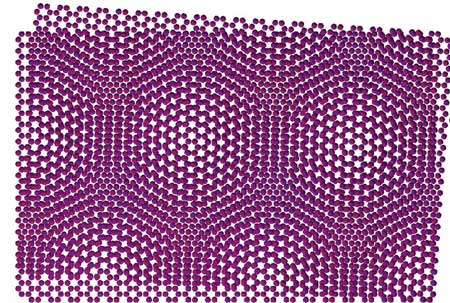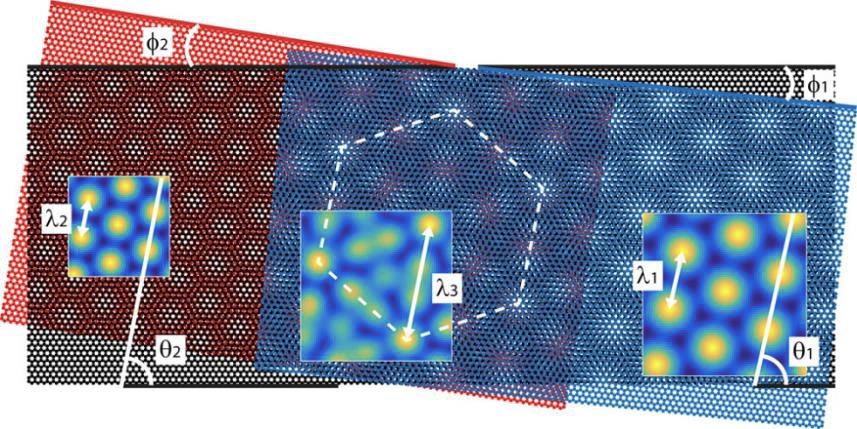Twistronics – at the intersection of nanotechnology and materials scienceContents
|
|
Definition of Twistronics |
|
| Twistronics is a field of study that emerged from the intersection of nanotechnology and materials science. It involves manipulating the electronic properties of two-dimensional (2D) layered materials, such as graphene, by precisely controlling the angle between the layers, also known as the twist angle. The term "Twistronics" was coined by combining "twist" and "electronics." | |
| The basic principle of twistronics comes from the Moiré patterns that form when two regular patterns are overlaid at a slight angle. A Moiré pattern is a large-scale interference pattern that can be seen with the naked eye. In the context of twistronics, these patterns form when two 2D lattices of atoms are overlaid with a small twist angle, causing the lattice to stretch and deform at a larger scale. | |
| This novel field has introduced groundbreaking implications for our understanding of physics and the potential development of futuristic technologies. | |
 |
|
| Atomic scale moiré pattern created by overlapping two skewed sheets of graphene. (Image: Wikicommons) | |
Background to Twistronics |
|
| The emergence of twistronics as a research field has been a result of the continuous exploration of two-dimensional (2D) materials. The journey began with the discovery and isolation of graphene in 2004, which subsequently earned the Nobel Prize in 2010. Considered the pioneer of 2D materials, graphene opened a pathway to the creation of various other monolayer materials with a broad range of chemistries and crystal structures. | |
| These 2D materials exhibited remarkable properties, contributing to various fields, from sensing technology to piezoelectrics. Each material had strong in-plane bonding and weak out-of-plane bonding, which led to the birth of a new pseudo-crystalline solid form known as van der Waals (vdW) layered solids, created by vertically stacking these 2D materials. | |
| However, scientists discovered that the properties of such stacked van der Waals heterostructures did not merely combine the individual properties of their respective layers. Instead, they were intricately affected by factors such as interlayer coupling, lattice reconstruction, and notably, the twist angle between the layers. This realization sowed the seeds for what would later be called twistronics. | |
| Twistronics focuses on how the twist angle between the layers in a vertically stacked 2D structure can dramatically alter the structure's band structure and properties. The field earned its name from the transformative effects observed at specific "magic" twist angles. It has been shown that the twist angle's effect can be as impactful as other crucial variables like doping, crystal structure, and stoichiometry, suggesting its significant promise for next-generation technologies. | |
| Thus, twistronics has become a fascinating area of exploration, shining a light on the nuanced behavior of 2D materials and their vast potential applications when their structural angles are 'twisted'. | |
 |
|
| Moiré patterns generated from overlaying hexagonal lattices. Three different lattices (red, black, and blue) consecutively superimposed in that order, where they represent hBN, graphene, and hBN, respectively. hBN and graphene have the same crystal structure, but the hBN in-plane lattice constant is 1.8% larger. The λ values show the size of the moiré pattern. Note, the moiré pattern changes with twist angle. (Reprinted with permission from doi:10.1021/acs.nanolett.8b05061) | |
Significance of Twistronics |
|
| The field of twistronics promises a wealth of scientific discoveries and transformative applications. The manipulation of twist angles in layered two-dimensional (2D) materials, forming moiré superlattice solids, offers the potential to unveil numerous unexpected quantum phenomena. As these novel behaviors often do not relate directly to the fundamental properties of the parent 2D crystals, the scope of the new knowledge to be discovered is vast and unpredictable. | |
| The importance of twistronics lies in the unprecedented control it provides over the electronic properties of materials, which could lead to new technologies and deepen our understanding of condensed matter physics. | |
| Designing Custom Materials: By choosing the right materials and twist angles, scientists can tailor the properties of these 2D systems to their needs. This could lead to the design of new materials with custom electronic properties, paving the way for new technologies. | |
| Superconductivity: The discovery of superconductivity in twisted bilayer graphene was a game changer. Superconductivity, a state in which materials conduct electricity without resistance, typically requires extremely cold temperatures. If this state could be achieved at higher temperatures, it could revolutionize technology, making electricity transmission much more efficient, among other benefits. | |
| Quantum Computing: The properties of these twisted materials are deeply entangled with quantum mechanics. As such, there is the potential to use these materials in the development of quantum computers, which rely on quantum phenomena to perform complex calculations much more quickly than traditional computers. | |
| Scientific Understanding: Perhaps most importantly, twistronics provides a relatively simple platform for exploring complex scientific phenomena. For instance, the study of twisted bilayer graphene and its unusual electronic properties has already led to new insights into the nature of superconductivity and magnetism. | |
| The potential combinations of 2D materials, twist angles, and layer thicknesses, gives rise to a staggering number of possible heterostructures for study. For instance, merely considering 100 different 2D materials and 30 different twist angles for a bilayer heterostructure presents 300,000 potential combinations. With the inclusion of additional layers, the possibilities quickly reach into the billions. While not all combinations will yield groundbreaking discoveries, even a small proportion of significant results would furnish ample material for research for years to come. | |
| The sheer number of potential combinations, however, presents a considerable challenge that cannot be addressed by trial-and-error approaches. Overcoming this hurdle requires a multidisciplinary, collaborative effort, combining accurate predictive theoretical tools, data-driven searches, and high-quality, precision synthesis of 2D materials. The development of searchable databases for electronic structures of 2D materials, utilizing first-principle approaches such as density functional theory, is a promising step towards this goal. | |
| In tandem with these efforts, methodologies for automated high-volume synthesis and precise stacking of 2D materials are being developed. Automation will not only hasten the discovery process but will also democratize access to these materials, enabling a broader range of experimentalists to contribute to and extend the field's discoveries. | |
| In conclusion, the significance of twistronics lies not only in its current discoveries but also in its vast untapped potential. With the appropriate strategies and collaborative effort, twistronics can pave the way for unparalleled scientific insights and transformative applications, reshaping our understanding of quantum phenomena. | |
| If you want to delve deeper into the science of twistronics we recommend this review article in Electronic Structure: "Twistronics: a turning point in 2D quantum materials" | |
Frequently Asked Questions (FAQs) about Twistronics |
|
What is Twistronics?Twistronics is an emerging field of condensed matter physics. It involves twisting the layers of 2D materials, like graphene, at specific angles to control electronic properties, leading to the discovery of new phenomena such as superconductivity and correlated insulating states.
What makes Twistronics unique?The unique aspect of Twistronics is that it allows manipulation of electronic properties through the twist angle, leading to drastically different behavior in the same material. This control is unprecedented and has the potential to open up new pathways in electronics and materials science.
Who discovered Twistronics?The concept of Twistronics was first studied in detail by physicists Pablo Jarillo-Herrero, Rafi Bistritzer, and Allan MacDonald. Their work on twisted bilayer graphene led to the recognition of this new field.
Why is graphene often used in Twistronics?Graphene, a single layer of carbon atoms, is often used because its 2D nature makes it suitable for twisting. Additionally, its excellent electrical conductivity and physical robustness make it a prime candidate for investigating the unique phenomena of Twistronics.
What are the potential applications of Twistronics?Twistronics has potential applications in designing next-generation electronic devices, quantum computing, energy storage, and even in studying fundamental questions in physics. However, it's still an active field of research and much is yet to be explored.
Is Twistronics related to Moiré patterns?Yes, Twistronics is closely related to Moiré patterns. When two layers of 2D material like graphene are twisted, they create a large-scale 'superlattice' called a Moiré pattern. This pattern can affect the material's electronic properties.
What does the term 'Magic Angle' mean in Twistronics?In Twistronics, the 'Magic Angle' refers to the specific twist angle (approximately 1.1° for graphene) at which the electronic properties of the material dramatically change, leading to phenomena such as superconductivity and correlated insulating states.
Can Twistronics work with materials other than graphene?Yes, Twistronics can work with other 2D materials such as transition metal dichalcogenides (TMDs), boron nitride, and more. The principle of twisting layers to alter electronic properties can be applied broadly, though the specific effects may vary with the material.
Is Twistronics related to quantum computing?The potential applications of Twistronics in quantum computing are being researched. The ability to control electronic states through the twist angle could be used to create qubits, the fundamental unit of quantum computing.
What are the challenges in the practical application of Twistronics?The practical application of Twistronics faces several challenges, such as achieving precise control of the twist angle, maintaining the stability of twisted layers, and addressing technical difficulties in fabrication and scalability. However, researchers are actively working to overcome these hurdles.
|
